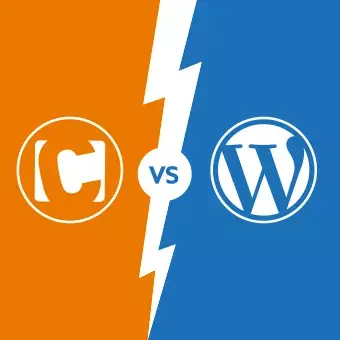Introduction
In the world of Content Management Systems (CMS), Contao and WordPress are two familiar names.
Both have significantly impacted the web development scene, and both platforms power a great number of websites worldwide. In this piece, we’ll explore the merits of each platform from the vantage point of a developer.
History and Background
Contao, founded in 2006 by Leo Feyer, initially concentrated on accessibility and search engine optimisation, quickly growing into a fully-fledged open-source CMS.
WordPress, on the other hand, emerged in 2003 from the efforts of Matt Mullenweg and Mike Little, initially as a user-friendly blogging tool but soon expanded its horizons.
Looking for a Contao Agency?
Ease of Use
Both Contao and WordPress prioritise user-friendliness, albeit aimed at different demographics.
Contao offers a more streamlined learning curve than you might initially expect. Its back-end interface is clean and intuitive, making it fairly accessible for those with some technical know-how. While offering substantial customisation options, Contao does require a certain level of understanding of its architecture. This makes it a popular choice for developers keen on crafting detailed, data-intensive websites.
WordPress is the epitome of user-friendliness. The platform’s vast array of plugins allows for quick functionality extensions without the need for large amounts of code. However, this simplicity can be a bit of a mixed blessing. Heavy reliance on plugins can lead to compatibility issues and performance issues.
Flexibility and Customisation
Both Contao and WordPress are well-known for their flexibility, but they achieve this in different ways.
From a developer’s perspective, WordPress brings with it an expansive library of ready-to-use solutions, which is great for a quick project rollout. Contao, on the other hand, demands a more hands-on experience, favouring those who value depth of customisation over the speed of implementation.
Contao
Contao takes a modular tack, offering developers the basic building blocks for creating custom digital experiences. While it may not deliver the immediate plug-and-play satisfaction that WordPress does, its fine-grained control over content presentation and user roles is second to none.
Contao’s theming system allows for highly personalized user experiences, but its flexibility shines through its modules, similar to WordPress plugins. However, implementing these modules effectively may require a deeper understanding. While Contao offers basic multilingual functionality in its core features, it has limitations. For example, it doesn’t inherently support content associations or language switching between website versions, often necessitating third-party plugins or custom solutions. Nevertheless, Contao remains a robust platform for creating unique web experiences.
A standout feature of Contao is its adeptness at handling ‘content relationships.’ For projects necessitating intricate data interaction—such as online directories or e-commerce platforms with multiple product attributes—Contao’s flexibility is unmatched.
WordPress
At its core, WordPress is engineered for extensibility. Its versatility largely stems from its extensive plugin ecosystem. With over 50,000 plugins available in the official repository alone, businesses can easily incorporate everything from SEO utilities to social media features and e-commerce functionalities.
Themes in WordPress are also crucial for visual and functional customisation and the WordPress Block Editor further simplifies design changes by offering real-time previews. However, it’s important to note that while plugins and themes bring convenience, they can sometimes conflict or overload the site if not chosen carefully.
Security
Both Contao and WordPress offer strong security features, but their effectiveness depends primarily on the vigilance of the administrators and developers overseeing the site.
Contao
The Contao API is designed with a strong focus on security, offering a structured process for code writing and review. Contao’s security team is vigilant, frequently issuing updates and advisories to keep the platform secure.
One of Contao’s standout features is its granular user access control, which allows administrators to define permissions down to the finest detail. This minimises unnecessary access, thereby reducing potential risks.
WordPress
As the most widely used CMS globally, WordPress is a frequent target for cyber threats. However, the core of WordPress is inherently secure, and most vulnerabilities stem from poorly coded or outdated plugins and themes. The WordPress team is highly proactive, consistently rolling out updates and patches to counter known security risks.
The WordPress community also plays a key role in the platform’s security. With so many eyes scrutinising the software, vulnerabilities are quickly identified and remedied. Additional layers of security, such as two-factor authentication, regular backups, and specialised security plugins, can further bolster a WordPress site.
Performance and Scalability
Performance is about more than just speed; it’s about delivering a consistent, responsive user experience as a site evolves and grows. Let’s explore how Contao and WordPress rise to these challenges.
Contao
Contao was engineered with complex, high-traffic websites in mind and built-in layers like advanced page caching and asset compression contribute greatly to performance.
Contao’s architecture is inherently designed for scalability – which is perhaps why it’s the CMS of choice for various large-scale organisations. Its ability to handle large volumes of content, along with its versatile content relationships, makes Contao a strong contender for data-intensive projects.
WordPress
Straight out of the gate, WordPress offers great performance. Its streamlined architecture ensures that websites load quickly for users. Initially conceived as a blogging platform, WordPress excels at managing text-rich sites without breaking a sweat.
However, as a site expands—both in content volume and user traffic—performance can become a sticking point. The plugins that broaden WordPress’s capabilities can also be its downfall. A poorly-coded plugin or an excessive number of plugins can bog down site performance.
To offset this, WordPress offers a variety of caching plugins and Content Delivery Network (CDN) integrations to bolster site speed. Coupled with a reliable hosting provider, these tools can make a significant difference. In terms of scalability, WordPress can manage large sites and handle spikes in traffic, but this often necessitates a mix of optimised hosting, meticulous database management, and routine performance checks.
Community and Support
An active community is the foundation of any open-source platform, and Contao and WordPress are no exceptions. These communities play a vital role in the ongoing development, security, and innovation of both platforms.
Contao
While Contao’s community is smaller in size compared to WordPress, there is no shortage of enthusiasm and technical expertise. The Contao community is highly regarded for its dedication to innovation and collaboration.
The community’s focus on security is particularly noteworthy. A dedicated security team, supported by community members, ensures that vulnerabilities are quickly identified and patched.
WordPress
Thanks to its global popularity, WordPress has one of the largest and most active user communities worldwide. This far-reaching network encompasses developers, designers, content creators, and everyday users alike and is a significant asset in keeping the platform up-to-date, secure, and aligned with the ever-changing needs of its user base.



